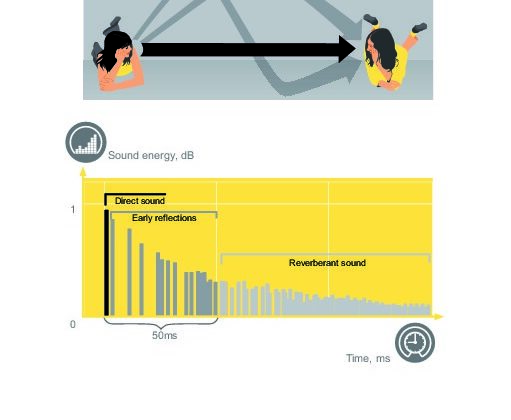
Reverberation (RT) time still remains the primary indicator of room acoustic response and RT is also known to be the only demand/descriptor in building regulations for room acoustics in healthcare facilities, schools and day care centres and offices. However, previous work and research for many years has shown that RT alone can be insufficient to describe the acoustic conditions in non-diffuse environments, especially in rooms where the typical solution is a sound absorbing suspended ceiling; the majority of absorption is on one surface which normally leads to a non-diffuse sound decay. Alternative parameters have been presented in many studies to evaluate the acoustic response better of such rooms: Speech Clarity (C50) and sound strength (Gain).
This article will briefly define and describe these three room acoustic descriptors – and hopefully give a better understanding of why they all together will give a better evaluation of room acoustic quality than just one of them. You will find a link to a calculation tool in end of the article.
Reverberation time
The reverberation time T is defined as the time in seconds required for the level of the sound to drop 60 dB after the sound source is turned off. It was developed by Sabine in the 1890s and still remains the preferred descriptor to evaluate room acoustics in rooms in schools, healthcare facilities and offices – even though most rooms in these buildings cannot be described as a diffused since the acoustic treatment (if any) is normally on one surface only; the ceiling. The usage of the Sabine equation will therefore not reflect reality in many cases.
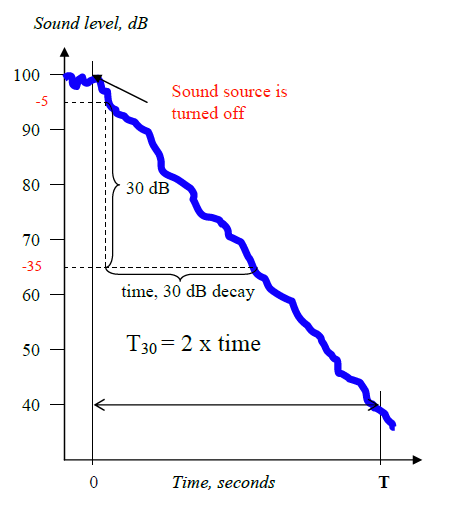
When measuring RT it is in practice difficult to reach full 60 dB decay due to e.g. background noise. Instead a decay range of 20 or 30 dB are commonly used. If you e.g. use a range of 30 dB the corresponding time has to be multiplied by two.
According to ISO 3382-2 the reverberation times given by the limited decay ranges are denoted T20 and T30, respectively and according to the standard, when determining T20 and T30, the evaluation does not start until the sound level has already fallen by 5 dB (the figure 1. RT. shows how T30 is determined).
Findings have shown that the initial part of the decay process is most important for the subjectively perceived reverberance of a room and to characterize the rate of sound decay in its initial part, the descriptor Early Decay Time (EDT) is used. EDT is defined as the time in which the first 10 dB fall of a decay curve occurs, multiplied by a factor 6.
If the reverberation curve is a straight line (solid line in fig. 2. RT.) the reverberation times T20, T30 and EDT will be equal.
However, if the decay curve is bent (dashed line in fig. 2. RT.) these descriptors will differ. The latter occurs typically in rooms with absorbent ceiling treatment.
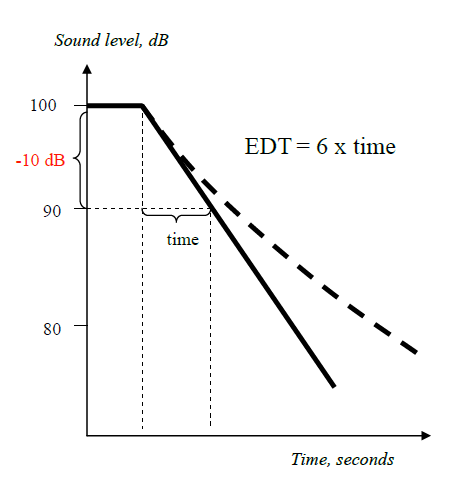
Good to know about RT
- Normally T20 is most frequently used in practice. This means that the slope of the decay curve in the interval -5 dB to -25 dB determines the reverberation time.
- Sabine formula assumes a diffuse sound field in the room. In the initial part of the sound decay the sound field is fairly diffuse. Since EDT (early decay time) is evaluated on the early part of the decay curve it corresponds better to Sabine than T20 and T30.
- At steady-state circumstances, i.e. when a constant sound power is fed into the room, the sound field is fairly diffuse in the sense that waves are travelling in all directions and the use of practical absorption factors is suitable. However, during the decay process, i.e. after the sound source is turned off, the sound field will become non-diffuse and normally the measured reverberation times are longer than estimated by Sabine formula.
- In rooms with acoustic ceilings the reverberation time is not only dependent on the amount of absorption in the room and the room volume as according to Sabine formula. In these rooms the reverberation time is influenced by:
- The volume and shape of the room
- The absorption of the acoustic ceiling. Especially the absorption for waves that hits the ceiling surface at large (steep) angles of incidence (grazing waves).
- The amount of sound scattering and absorbing furniture and equipment in the room. Especially scattering objects along the walls are important for the sound diffusion.
- The absorption for walls and floor.
- At high frequencies there will even be a small contribution due to the air absorption.
Speech Clarity (C50)
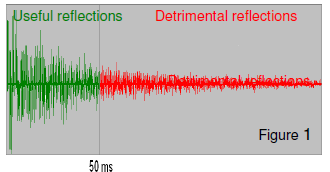
C50 is expressed in dB and it is related to the attribute clarity. It is an objective measure of the clarity or intelligibility of speech. The basis for C50 is the fact that late reflections are unfavorable for understanding speech because it causes speech sounds to merge making speech unclear. However, if the delay does not exceed a certain time limit, the reflections will contribute positively to the intelligibility.
The critical time limit separating useful from detrimental reflections is approximately 50 ms (milliseconds). For younger people the limit is slightly lower. C50 is derived from the impulse response when making acoustic measurements. The impulse response is the pattern showing how reflections from an impulse sound, like a handclap or a pistol shot, arrives at different times to the listener. In fig. 1. C50 an impulse response is shown where the region for useful and detrimental reflections are indicated. Figure 2 is an example of an early and a late reflection.
C50 measure the ratio of the early sound energy (between 0 and 50 ms) and the late sound energy (that arrives later than 50 ms). It is derived as:
Good to know about speech clarity – the speech clarity is influenced by;
- The location and the amount of absorption.
- For example an absorbing wall panel on the rear wall in large/long room reduces late reflections.
- Reflecting surfaces, preferably close to the speaker or sound source, will increase the speech clarity.
- The shape of the room. It is preferable to have a room shape that supports a short distance between the speaker and the listeners. Compare e.g. the Greek amphitheaters.
- The signal to noise ratio i.e. the speech level in relation to the background noise.
- Sound-scattering objects on the walls or wall absorbers since these will eliminate disturbing echoes that can occur between walls – “flutter echo”.
Clarity and Deutlichkeit/definition – C50 and D50
A similar measure to C50 is Deutlichkeit or Definition. It is denoted D50 and expressed in %. D is the ratio between the sound energy between 0 and 50 ms. and the total energy of the impulse response. Knowing C50 the value of D can be calculated. The relation between C50 and D50 is:
Thus, it is not necessary to measure both parameters. If for example C50=8 dB this corresponds to a D50 value of roughly 0.86 (86 %). This means that 86 % of the total sound energy is in the region 0 to 50 ms.
Strength (Gain/G)
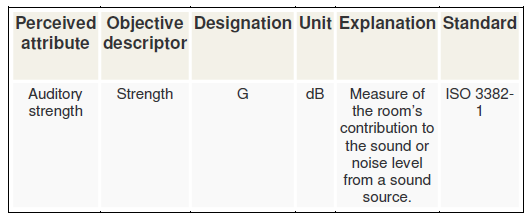
Auditory strength is the level at which we experience sound. A reverberant room gives a higher sound level than a room with added sound absorption. The measure (objective descriptor) Strength states the sound level in the real room in relation to the sound level in an anechoic room with the same sound source. The Strength value demonstrates the room reflections’ effect on the sound level. Strength is mainly influenced by:
- The sound absorption of the room
- Distance between sound source and receiver
Strength (G) can be measured using a calibrated omnidirectional sound source (omnidirectional sound source is a loudspeaker sending out the same amount of sound energy in all directions).
Strength is the ratio (difference) of the sound energy of the measured impulse response at a certain distance to the response measured in free field (an anechoic room) at a distance of 10 meters from the sound source. Normally Strength is measured in octave bands, typically 125 – 4 000 Hz. Averaging is performed (=mean value is calculated) for several receiver (microphone) positions – normally 5 in an ordinary room.
Example:
SPL* in real room = 70 dB
SPL* in anechoic room = 60 dB
G = 70 dB minus 60 dB = 10 dB
(* Sound Pressure Level)
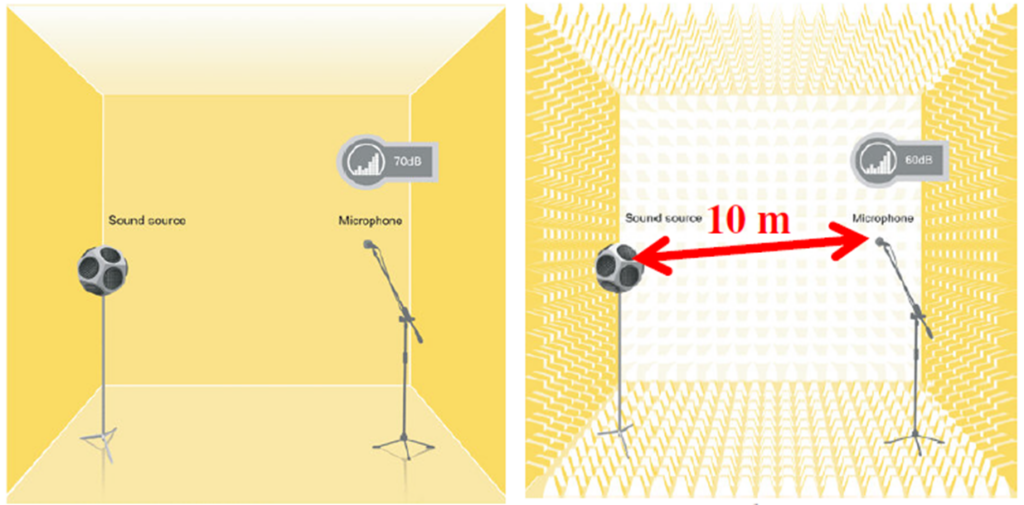
When using an omnidirectional sound source with a known sound power level, Strength (G) can be obtained from this equation: G = Lp – Lw + 31 dB where Lp = the sound pressure level measured at a measurement point and Lw = the sound power level of the sound source (according to ISO 3741).
Do you want high or low Strength/ Gain?
In a room with high sound levels, and where you want to create a calmer sound environment, you want a low Strength or G value. In a performance room, like a concert hall for classical music etc., or larger lecture halls, you want enough sound reaching each seat position. In these cases you don’t want the Strength value to be too low.
A suitable Strength or G value for e.g. classrooms may depend on what type of teaching or learning that takes place – normally the aim is lower values in multi talker environments to avoid Lombard. In a normal sized classroom (not too long or large) you have enough direct sound coming to listeners, and the risk of having too low Sound Strength is usually not an issue.
Calculation tool
It is possible to find various calculations tools based on the Sabine formula online – but only a few tools show more than reverberation time. Ecophon has recently published an acoustic calculator which is based on air flow resistance and also includes C50 and Gain. You can try the calculator here.


